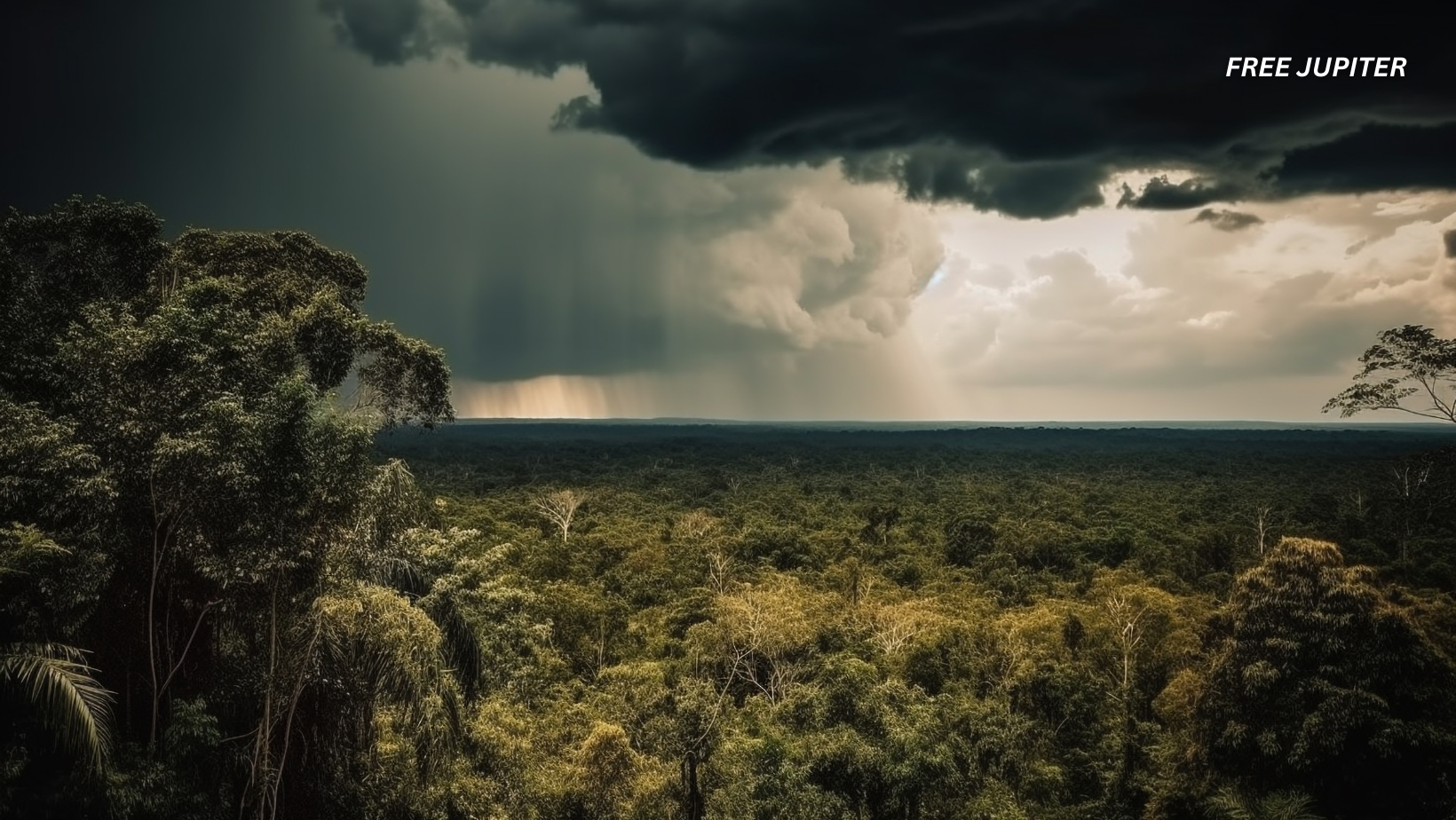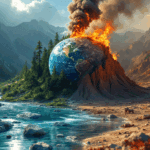When most people think of trees, they imagine shade, oxygen, and perhaps a nice breeze. But in the Amazon rainforest, trees are more than silent witnesses to the weather—they are its architects. These towering giants don’t just endure the climate around them; they actively shape it, orchestrating rainfall patterns, river floods, and even the timing of the seasons.
It’s almost as if the Amazon has its own built-in weather machine, fueled not by steel and gears, but by billions of living, breathing trees.
The Skyward Pump: Billions of Gallons in Motion
Every single day, the Amazon’s forest canopy performs a staggering trick. Through a process called transpiration, trees pull water up from the ground and release it into the atmosphere through their leaves. This isn’t just a trickle—it’s a flood of vapor that collectively amounts to about 20 billion tons of water per day.
To put that in perspective, that’s more water than flows out of the Amazon River itself, which is the largest river on Earth by volume. If the river is the Amazon’s bloodstream, then transpiration is its breath—a slow, steady exhale that moistens the sky.
Scientists often describe this phenomenon as the “flying river.” It’s an invisible current of water vapor that floats above the canopy, drifting across South America. As it travels, it helps irrigate vast farmlands in Brazil, Paraguay, and Argentina, sustaining crops like soybeans, coffee, and sugarcane. Without the Amazon’s “flying rivers,” agriculture across the continent would dry up, making the rainforest not just a local treasure but a global lifeline.
Read more: Scientists Find a Single Tree Can Capture Half a Metric Ton of CO₂ Annually, Cooling The Planet
Tiny Seeds of Storms
Of course, releasing water vapor is only half the story. For clouds to form, water droplets need a nucleus—a tiny particle around which they can gather and grow heavy enough to fall as rain. In the Amazon, trees also supply this missing ingredient.
From leaf oils, tree resin, and even the spores of fungi living in the forest, microscopic particles drift upward, serving as cloud seeds. These airborne specks allow vapor to condense more easily, leading to cloud formation and, eventually, rainfall.
This is especially important during the dry season, when the forest faces several months of limited rain. During this time, trees increase their output of vapor and particles, effectively priming the atmosphere and kick-starting the rainy season earlier than it would arrive naturally. In other words, the trees don’t just wait for rain—they call it down from the sky.
When the Floods Come
The shift from dry to wet season in the Amazon is dramatic, almost theatrical. When the rains arrive, the Amazon River swells until it bursts its banks, flooding vast stretches of forest. For several months, an area larger than the state of Montana disappears under water, with flood depths reaching up to 40 feet.
To outsiders, this might sound catastrophic. But in the Amazon, it is a cycle as old as the forest itself. The flooding spreads nutrient-rich sediments across the land, nourishing the soil and fueling new plant growth. Aquatic life flourishes, and animals quickly adapt to the transformation.
Monkeys, sloths, and jaguars retreat to the treetops. Meanwhile, creatures of the river seize their moment: piranhas, giant catfish, and the mystical pink river dolphins glide through submerged forests as if they were new hunting grounds. It’s a scene so surreal that explorers in the past often described it as sailing through a “sunken jungle.”
The rainforest, then, is not just passively watered by the skies—it is an active partner in a grand seasonal dance between land, water, and atmosphere.
Read more: Research Shows That Music Significantly Boosts Infant Brain Development
What Happens When the Forest Shrinks?
Here’s where things take a sobering turn. The Amazon’s rain-making power depends on the presence of its trees. But with deforestation advancing due to logging, mining, cattle ranching, and soybean farming, this delicate balance is at risk.
Studies have shown that if enough of the forest is cut down, the region could reach a tipping point. Without sufficient trees to pump vapor into the air and provide cloud seeds, rainfall would decline dramatically. The dry season would lengthen, fires would spread more easily, and large portions of the rainforest could transform into dry savanna.
This wouldn’t just affect the Amazon itself. The “flying rivers” that water South America’s farmland would weaken, threatening food supplies and economies across the continent. Even global weather patterns could shift, since the Amazon plays a role in regulating atmospheric circulation.
It’s a stark reminder that the forest is not just a backdrop to human activity—it is a planetary system in its own right.
Echoes Around the World
While the Amazon is the most famous example of a “rain-making forest,” it is not the only one. Other forests, like the Congo Basin in Africa and the tropical forests of Southeast Asia, also contribute significantly to local rainfall patterns.
For example, in the Congo, research has revealed that deforestation could reduce rainfall by as much as 35%, with devastating consequences for millions of people who rely on rain-fed farming. Similarly, in India, the monsoon system has been linked to forest cover—remove too many trees, and rainfall becomes less predictable.
This suggests that forests around the globe share a hidden superpower: the ability to engineer their own climate.
A Story of Science and Indigenous Knowledge
Interestingly, the idea that forests summon rain isn’t entirely new. Indigenous communities in the Amazon have long held beliefs about the forest’s ability to call down the rains. While their explanations may not have involved microscopic particles or water vapor, their lived experience of the forest’s rhythms matched what modern science is only now confirming.
Today, researchers are collaborating with Indigenous peoples, combining satellite data and climate models with centuries-old ecological knowledge. Together, they paint a picture of the Amazon not as a passive environment, but as a living system with its own agency and intelligence.
The Bigger Picture: Why It Matters for Us
So why should someone living far from the Amazon care if trees are making it rain thousands of miles away? The answer is simple: what happens in the Amazon does not stay in the Amazon.
The rainforest acts as a carbon sink, absorbing vast amounts of CO₂ and slowing climate change. Its flying rivers sustain agriculture that feeds millions. Its biodiversity holds medicines and materials yet to be discovered. And its ability to summon rain stabilizes weather patterns far beyond South America.
Cutting down the forest is like tampering with the gears of Earth’s climate engine. Once those gears jam, the consequences ripple outward—droughts in some places, floods in others, and unpredictable shifts in growing seasons worldwide.
Read more: Mexico Releases 350 Dolphins Into The Wild After Banning Marine Mammal Shows
Closing Thoughts: The Rainmakers
The image of trees as quiet, passive beings fades quickly when you consider the Amazon. Here, trees breathe out rivers of vapor, exhale the seeds of storms, and summon rains that flood the land with life. They aren’t just part of the rainforest—they are its orchestra, its architects, and its timekeepers.
If the Amazon were to lose its trees, it would lose its heartbeat. The rains would falter, the river would shrink, and the grand seasonal drama that has played out for millions of years would fall silent.
Protecting the Amazon, then, is not simply about saving trees. It’s about safeguarding one of Earth’s greatest living weather machines—an intricate, self-sustaining system that, in its own quiet way, keeps the planet alive.
Featured image: Freepik.
Friendly Note: FreeJupiter.com shares general information for curious minds. Please fact-check all claims and double-check health info with a qualified professional. 🌱










